IRAQ
Baghdad

Baghdad
Baghdad
Baghdad is the capital of Iraq and the governorate of the same name. According to the 2011 census, the population of Baghdad is 7,216,040. It is the largest city in Iraq and the second largest city in the Arab world after Cairo.
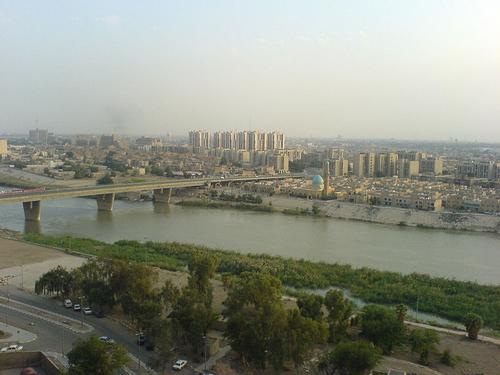 BaghdadPhoto: Public domain
BaghdadPhoto: Public domain
The city developed in the second half of the 19th century and took on the character of a modern metropolis. Baghdad was badly damaged during the Persian Gulf War (1990-1991) by air raids and again suffered infrastructural damage during the Iraq war, which began in 2003. Iraq was involved in the war until 2010 and Baghdad became the target of constant terror attacks that continue to this day.
Location
The coordinates of Baghdad are: 33° 325 North Latitude and 44° 422 East Longitude.
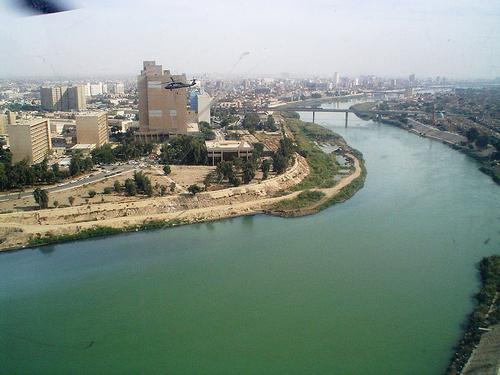 Baghdad on the TigrisPhoto: Robert Smith in the public domain
Baghdad on the TigrisPhoto: Robert Smith in the public domain
Baghdad lies on a vast plain along the Tigris River, some 530 km from the Persian Gulf in the heart of ancient Mesopotamia. Baghdad is the largest city in Iraq and one of the most densely populated urban areas in the Middle East. The Tigris divides Baghdad into two halves, the eastern half is called Risafa and the western half is known as Karkh. The city is built on low, completely flat land of alluvial origin, the result of periodic flooding by the river.
Weather
Baghdad has a dry, subtropical, desert climate and is one of the hottest cities in the world. In the summer from June to August, the average maximum temperature is 44° C and the sun shines brightly. Precipitation is almost nil at this time of year. Temperatures of over 50° C in the shade are common and night-time temperatures in summer almost never fall below 24° C.
History
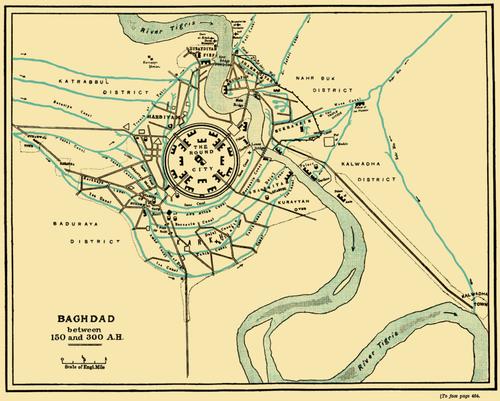 Baghdad map from the 9th centuryPhoto: Public domain
Baghdad map from the 9th centuryPhoto: Public domain
Baghdad was founded on 30 July 762 by Caliph Al Mansur as the capital of the Abbasid dynasty. For the next 500 years Baghdad was the most important cultural centre of Arab and Islamic civilisation and one of the largest cities in the world, partly due to its favourable position along the Tigris River, which gave it control over the trade routes. In the central square of Baghdad, the Golden Gate Palace was built. The palace was the residence of the caliph and his family. A green dome 39m high is the central part of the palace. Many stories from the Thousand and One Nights are set in Baghdad.
In the Middle Ages, Baghdad was the largest city in the world with an estimated population of 1,200,000. In 1258 the city was conquered by the Mongol leader Hülegü, the grandson of Chengiz Khan. The city was almost completely destroyed. In the following years, the importance of the city waned under Mongol power.
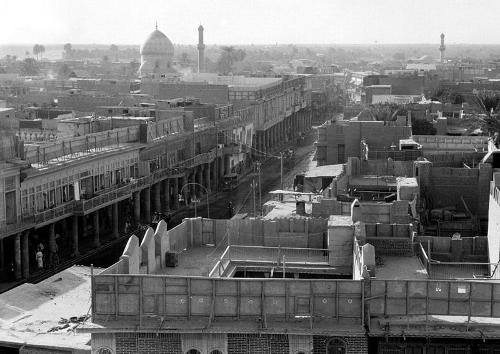 Baghdad in 1932Photo: Public domain
Baghdad in 1932Photo: Public domain
In 1534 Baghdad was conquered by the Ottoman Turks. From 1920 Baghdad became the capital of the British Mandate of Mesopotamia and after 1932 Baghdad became the capital of the Kingdom of Iraq. Iraq formally became independent in 1932. On 14 July 1958, members of the Iraqi army staged a coup to overthrow the Kingdom of Iraq. King Faisal II, along with members of the royal family and the former prime minister, were assassinated in the coup.
Iraq has a huge supply of petroleum, due to the sudden increase in the price Baghdad experienced a period of prosperity in the years from 1970 onwards. The Iran-Iraq war in the 1980s killed thousands of inhabitants. Iran launched a number of missile attacks on Baghdad. During the 1991 Gulf War and the 2003 invasion by US-led coalition forces, Baghdad suffered massive damage. The infrastructure of Baghdad was destroyed by the large-scale air raids on the city during the two wars.
Sights
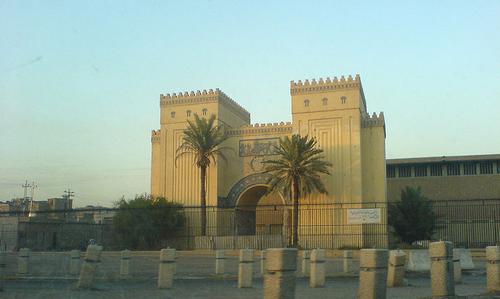 National Museum in BaghdadPhoto: Public domain
National Museum in BaghdadPhoto: Public domain
A well-known museum is the National Museum of Iraq with its priceless collection. Thousands of ancient manuscripts in the Royal Library were lost before and during the 2003 invasion of Iraq.
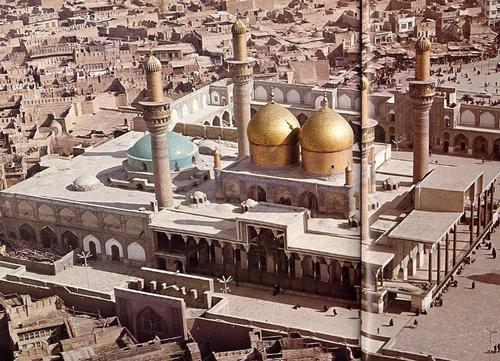 Al Kadhimain Mosque BaghdadPhoto: Ligadier Truffaut CC 2.0 no changes made
Al Kadhimain Mosque BaghdadPhoto: Ligadier Truffaut CC 2.0 no changes made
The Al Kadhimain, built in 1515, is one of the most important religious sites in Iraq. One of the oldest buildings is the 12th century palace of the Abbasids. It is located in the historical core of the city, close to other historical buildings such as the Saray building and the Al-Mustansiriyah School (also from the Abbasid period).
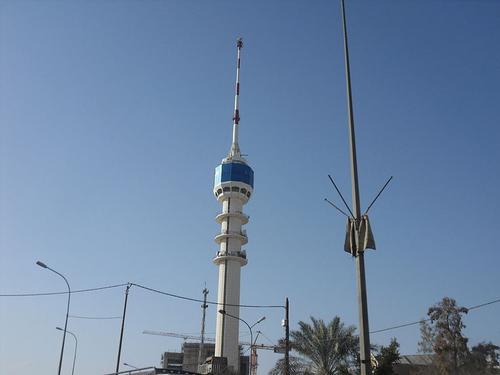 Baghdad TowerPhoto: Makaay31 in the public domain
Baghdad TowerPhoto: Makaay31 in the public domain
Other attractions include the Baghdad Tower, now the Ma'amoon Telecommunications Centre Tower. There is a revolving restaurant with a panoramic view at the top of the tower. Also worth visiting are the Khan Murjan and Sahat Al Tahrir (Liberation Square) in central Baghdad.
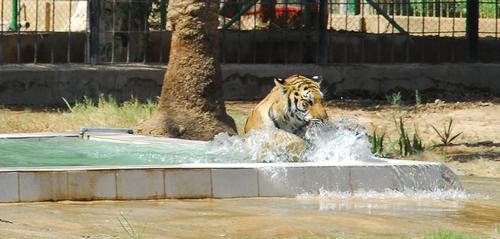 Baghdad zoo slowly recoversPhoto: DVIDSHUB CC 2.0 Generic no changes made
Baghdad zoo slowly recoversPhoto: DVIDSHUB CC 2.0 Generic no changes made
Al-Zawra'a Park is located in the centre of Baghdad. A famous market is the souq Saray (Saray market). The Baghdad Zoo was the largest zoo in the Middle East. In 2003 only 35 of the 650 animals survived the fighting.
Meanwhile, there are again just over 1000 animals in the recovering zoo.
Tips
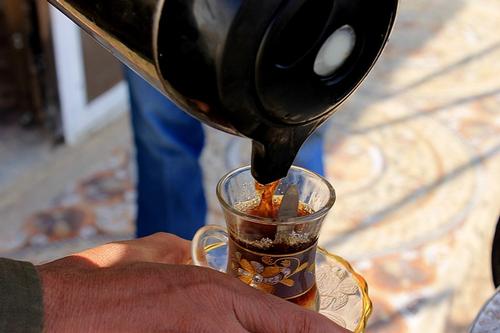 Drinking coffee concludes the meal in BaghdadPhoto: Public domain
Drinking coffee concludes the meal in BaghdadPhoto: Public domain
The inhabitants of Baghdad place great emphasis on hospitality; guests may be invited to a traditional Iraqi meal. The meals usually start with a starter, followed by soup, then a main course and finally a salad. The dessert often consists of fruit. The meals are a social experience. In many families, it is customary to serve the guests first. The host may feel offended or disappointed if the guest does not taste every dish.
Useful links Baghdad
BBC Country ProfilesWorld Fact Book Explore all Countries
How to call
Last updated November 2025
Copyright: Team - The World of Info